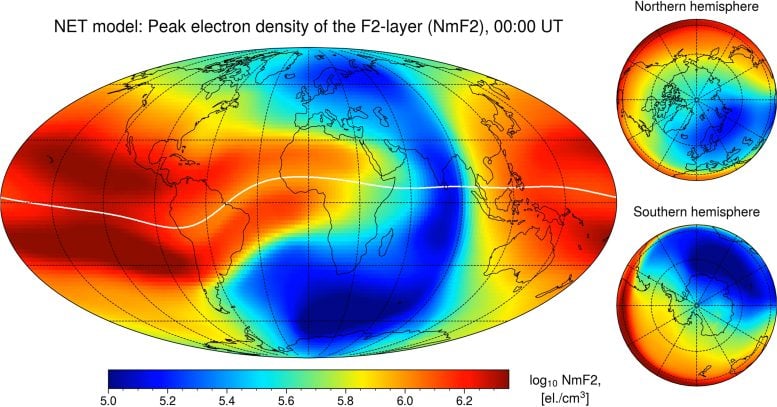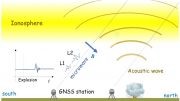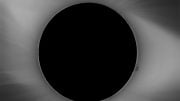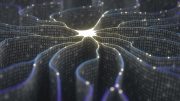
The ionosphere is a layer of the Earth’s upper atmosphere that is ionized by solar radiation and plays a crucial role in communication and navigation.
Neural networks have significantly improved our ability to reconstruct the Earth’s atmospheric layer, making it possible to achieve much more accurate results. This has significant implications for satellite navigation, among other applications.
The ionosphere, a region of geospace located between 60 and 1000 kilometers above Earth, disrupts radio signal transmission from global navigation satellite systems (GNSS) due to its electrically charged particles. This interference poses challenges for the increasing precision demanded by these systems in both research and practical applications, such as autonomous driving or accurate satellite orbit determination.
To compensate for ionospheric delays, which are a major source of error in GNSS applications, models of the ionosphere and its fluctuating, dynamic charge distribution can be utilized. A new ionospheric model has been introduced by researchers Artem Smirnov and Yuri Shprits from the GFZ German Research Centre for Geosciences. This model, which is based on neural networks and 19 years of satellite measurement data, was published in the journal Scientific Reports.
In particular, it can reconstruct the topside ionosphere, the upper, electron-rich part of the ionosphere much more precisely than before. It is thus also an important basis for progress in ionospheric research, with applications in studies on the propagation of electromagnetic waves or for the analysis of certain space weather events, for example.

Electron density of the Ionosphere around the Earth for a certain point of time: high values in red, low values in blue. The white line marks the geomagnetic equator. Credit: Smirnov et al. (2023) – Scientific Reports
Background: Importance and complexity of the ionosphere
The Earth’s ionosphere is the region of the upper atmosphere that extends from about 60 to 1000 kilometers in altitude. Here, charged particles such as electrons and positive ions dominate, caused by the radiation activity of the Sun – hence the name. The ionosphere is important for many scientific and industrial applications because the charged particles influence the propagation of electromagnetic waves such as radio signals.
The so-called ionospheric propagation delay of radio signals is one of the most important sources of interference for satellite navigation. This is proportional to the electron density in the space traversed. Therefore, a good knowledge of the electron density can help in correcting the signals. In particular, the upper region of the ionosphere, above 600 kilometers, is of interest, since 80 percent of the electrons are gathered in this so-called topside ionosphere.
The problem is that the electron density varies greatly – depending on the longitude and latitude above the Earth, the time of day and year, and solar activity. This makes it difficult to reconstruct and predict them, the basis for correcting radio signals, for example.
Animation of the changing electron density of the Ionosphere around the Earth over three full days: high values in red, low values in blue. The white line marks the geomagnetic equator. Credit: Smirnov et al. (2023) – Scientific Reports
Previous models
There are various approaches to modeling electron density in the ionosphere, among others, the International Reference Ionosphere Model IRI, which has been recognized since 2014. It is an empirical model that establishes a relationship between input and output variables based on the statistical analysis of observations. However, it still has weaknesses in the important area of the topside ionosphere because of the limited coverage of previously collected observations in that region.
Recently, however, large amounts of data have become available for this area. Therefore, Machine learning (ML) approaches lend themselves to deriving regularities from this, especially for complex non-linear relationships.
A new approach using machine learning and neural networks
A team from the GFZ German Research Centre for Geosciences around Artem Smirnov, Ph.D. student and first author of the study, and Yuri Shprits, head of the “Space Physics and Space Weather” section and Professor at University Potsdam, took a new ML-based empirical approach. For this, they used data from satellite missions from 19 years, in particular CHAMP, GRACE, and GRACE-FO, which were and are significantly co-operated by the GFZ, and COSMIC. The satellites measured – among other things – the electron density in different height ranges of the ionosphere and cover different annual and local times as well as solar cycles.
With the help of Neural Networks, the researchers then developed a model for the electron density of the topside ionosphere, which they call the NET model. They used the so-called MLP method (Multi-Layer Perceptrons), which iteratively learns the network weights to reproduce the data distributions with very high accuracy.
The researchers tested the model with independent measurements from three other satellite missions.
Evaluation of the new model
“Our model is in remarkable agreement with the measurements: It can reconstruct the electron density very well in all height ranges of the topside ionosphere, all around the Globe, at all times of the year and day, and at different levels of solar activity, and it significantly exceeds the International Reference Ionosphere Model IRI in accuracy. Moreover, it covers space continuously,” first author Artem Smirnov sums up.
Yuri Shprits adds: “This study represents a paradigm shift in ionospheric research because it shows that ionospheric densities can be reconstructed with very high accuracy. The NET model reproduces the effects of numerous physical processes that govern the dynamics of the topside ionosphere and can have broad applications in ionospheric research.”
Possible applications in ionosphere research
The researchers see possible applications, for instance, in wave propagation studies, for calibrating new electron density data sets with often unknown baseline offsets, for tomographic reconstructions in the form of a background model, as well as to analyze specific space weather events and perform long-term ionospheric reconstructions. Furthermore, the developed model can be connected to plasmaspheric altitudes and thus can become a novel topside option for the IRI.
The developed framework allows the seamless incorporation of new data and new data sources. The retraining of the model can be done on a standard PC and can be performed on a regular basis. Overall, the NET model represents a significant improvement over traditional methods and highlights the potential of neural network-based models to provide a more accurate representation of the ionosphere for communication and navigation systems that rely on GNSS.
Reference: “A novel neural network model of Earth’s topside ionosphere” by Artem Smirnov, Yuri Shprits, Fabricio Prol, Hermann Lühr, Max Berrendorf, Irina Zhelavskaya and Chao Xiong, 24 January 2023, Scientific Reports.
DOI: 10.1038/s41598-023-28034-z






Be the first to comment on "Powered by Neural Networks – Scientists Develop More Precise Model of the Earth’s Ionosphere"